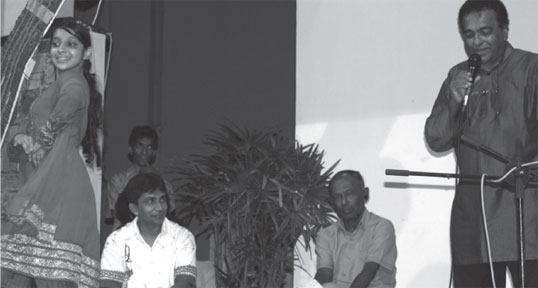
Gee Rasa Vinisa:
Seminal discourse on classic song
By Ranga CHANDRARATHNE
I had the privilege of taking part in a discourse on classic songs
recently held at the University of Wayamba. Although several speakers
gave lectures on diverse aspects of Sinhala song from the Nurthi Gee
(songs in drama) to the modern classical and semi-classical songs, what
struck me most were the lectures by actor Nissanka Diddeniya and W.A
Abeysinghe.
With his enigmatic demonstrations, Nissanka Diddeniya traced back the
evolution of the Nurthi Gee or drama songs in Sri Lanka. The era in
which drama songs flourished was the time when John de Silva made
dramas. One of the prominent features of John de Silva's drama was the
vital role the song played in the plot. Songs were primarily used to
intensify the zest. The canon of songs produced in the period are still
popular.
For instance, the song Danno Buddunge (About the Buddha) sung by W.D
Ameradeva is one such song which epitomises the quintessential
characteristics of drama song. Though it is of little literary value,
the combination of lyrics with music produces the intended effect on the
listeners. However, the importance of Nurthi Gee lies not in their
literary or artistic value but in its place in Sinhalese song as the
precursor to the modern Sinhala song.
 |
|
Nissanka Diddeniya and
Dr.W.A Abeysinghe during the demonstration at Wayamba
University |
W.A Abeysinghe stressed on literary value of the songs. For instance,
he pointed out those songs such as Danno Buddunge remains popular not
purely on account of its literary value but on the overall effect it
generates. He pointed out that the lasting value of a song lies in the
rich literary value of the lyrics and not merely on account of its
ability to please the audience.
Art song
The birth of modern art song marks a seminal trajectory in the
evolution of song as a distinct art form. It primarily rejected two
popular notions in the mid 16th century polyphony, more than one melody
is played or sung simultaneously. Firstly, it was believed that a given
piece of vocal music could be played at different times in any number of
alternative ways (Solo, ensemble or instrumental) and secondly the idea
that lyric is subordinate to music.
It was in the mid-16th century that a greater attention began to be
paid on textual interpretation. Special rhythms were used to emphasise
the emotionally significant texts in polyphonic compositions. Though the
modern art song can be defined as "poem set to music", it strives to
blend music and literature. It is based on four elements: poem,
composer, singer and accompanist. So the art song is the end result of
the combined effort of the four elements.
The composer of music uses his or her skills to embellish the lyric,
sometimes realising potential interpretations in the text. In a well
crafted art song, the composer creates a duet between the accompanist
and the vocalist to paint a picture that the lyricist has envisioned.
The performance of art song breathes life to the text through the
complementary and well coordinated partnership among the four elements.
The 17th century art song shows, among other things, the sensitivity of
the composer to the individual words, to the prosody and the overall
character of the text.
In the 17th and 18th centuries, the singer, primarily, serve as the
prime interpreter of the text. It was during the 19th century that art
song reached its climax in expression and appreciation. Starting with
Schubert, the leading Romantic songwriters learned to exploit the device
of varying a strophic melody. The composer would use a basic musical
framework for each stanza but change voice and accompaniment details to
suit the progressing text. This concept eventually evolved into
through-composed songs with music well integrated into the text.
Evolution of Sinhalese art song
Sri Lanka has a long history of art song. However, it was Cumaratunga
Munidasa . The next phase of the evolution of art song was marked by the
lyricists like Chandrarathne Manawasinghe, Madawala S Ratnayake, Ananda
Samarakoon and Sunil Shantha. The lyrics produced in the era were
prominent for the diverse experiments that the poet or lyricist carried
out in writing the songs. For instance, in Ananda Samarakoon's songs
such as Punchi Suda, Sumano..Sumano , the lyricist has used of dialogue
form effectively. It was the Radio Ceylon or now the SLBC which promoted
art song through its popular programmes such as Maduvanthi and song's
drama such as Manohari. Mahagamasekara's programme 'Maduvanthi "with
W.D. Ameradeva led to fruitful outcomes in the Sinhalese arts song.
In the programme, experiments both in music and the structure of song
marked an important phase in the evolution of Sinhalese art song.
For instance, W.D Ameradeva did a number of experiments with tune
motifs from folk poem while Mahagamasekara experimented with the
structure of the song.
It is obvious that a song will stand the test of the time, only if it
contains philosophical thoughts which are universal.
It is this property which has made some of the songs immortal and
still popular. For instance, songs such as Irahada Payana Loke,
Sannaliyane and Sandekaluvara Galahalenavita are still widely
appreciated. Modern lyricists have experimented with the Sinhala song,
embellishing it with layers of meanings. For instance, use of metaphor
is one of the effective ways in which lyric is made meaningful and
philosophical. Usually in Sinhalese songs metaphors are formed by fusing
of nouns. For example, in his song Sanda Kaluvara gala halenna vita ,
metaphors have been formed by the fusion of noun and verb. Sanda
Kaluvara gala halenna vita (gathering darkness) and Senehasa Dalvunu
Nivasa Soya Emi ( come in to the house lit up with warmth ) are potent
metaphors.
Although there are no specific set of rules as to how a novice should
pen a song, it is imperative for a budding lyricist to conduct a
self-study on the existing body of lyrics and the linguistic and
literary strategies employed by veteran lyricists such as
Mahagamasekara, Chandrarathne Manawasinghe and Madawala S Ratnayake.
The discourse on classic songs was of educational value to university
students particularly in appreciating and assessing songs contributing
to uplifting the public taste. The programme was coordinated by
Wayamba-FLICT project coordinator Dhanesh Liyanage (Senior Lecturer,
Department of Food Science and Technology, Faculty of Livestock,
Fisheries and Nutrition). The programme was assisted by Wayamba
University and FLICT (Facilitating Initiatives for Social Cohesion and
Transformation). The initiative was facilitated by Dr. Wijaya
Jayathilake, Program officer- Ms. Humira Musammil, frogram officer- Ms.
Hasini Haputhanthri and Vice Chancellor- Prof. ANF Perera, Registrar EMG
Ekanayake, Bursar U Dharmadhasa, Dean Faculty of Livestock, Fisheries
and Nutrition Dr. KDRR Silva.
Performance artists and others included -Nissanka Diddeniya and
Priyanwada Madubashini , Tabla and Maddalaya- Ranjith Wickramaratne,
Senior Lecturer- University of Visual and Performing Arts of Sri Lanka.
, Harmonium- Sithara Fonseka, , Sri Lanka and Critics Dr. W.A.
Abeyesinghe (Famous lyricist, Attorney-at-Law, and council member of
Wayamba University of Sri Lanka.
The programme was moderated by B.P.A. Jayaweera (Senior Lecturer,
Wayamba University of Sri Lanka).
|

